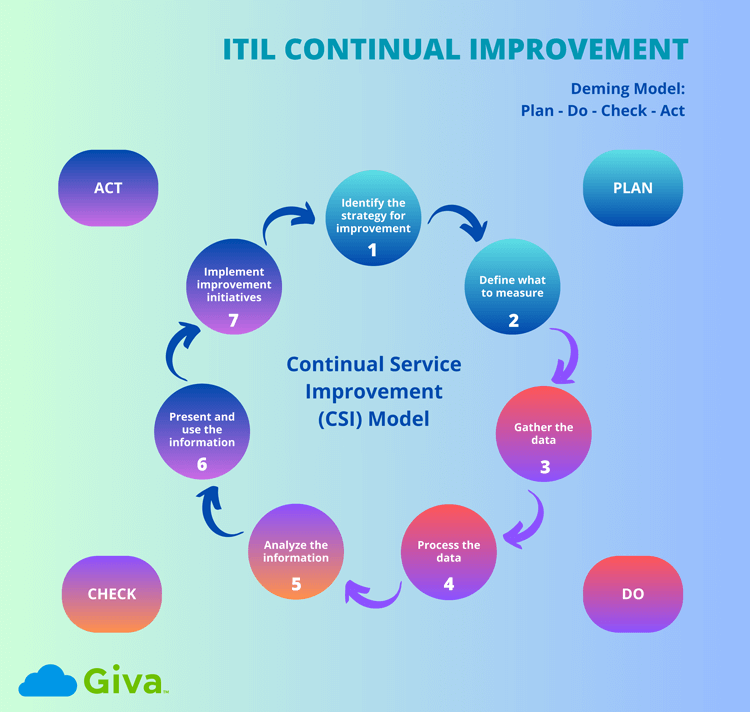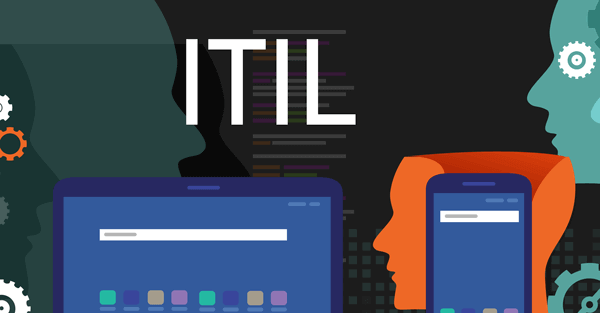The IT Service Management (ITSM) and Information Technology Infrastructure Library (ITIL®) frameworks provide organizations with best practices for managing IT services. Within these frameworks, the continuous improvement model is a critical component that enables organizations to continually enhance their IT service delivery. The Continuous Service Improvement (CSI) model, developed by AXELOS, offers a structured approach to driving continuous improvement in ITSM.
ITIL Continual Service Improvement (CSI) Model and the Deming Model
The CSI model consists of seven steps that guide organizations through the process of identifying, implementing, and evaluating improvements in IT services. These steps can be tied to the Deming Model, also known as the Plan-Do-Check-Act (PDCA) cycle, which is a widely recognized framework for continuous improvement strategies. Here is an overview of each step in the CSI model and how they align with the Deming Model:
- Identify the strategy for improvement (Plan): The first step in the CSI model is to identify the strategic goals and objectives for improvement. This aligns with the "Plan" phase in the Deming Model, where organizations establish improvement goals and define metrics to measure progress. By setting clear objectives, organizations can focus their efforts on areas that require attention and align improvement initiatives with the overall business strategy.
- Define what to measure (Plan): In the CSI model, organizations define what to measure by identifying Key Performance Indicators (KPIs) to monitor and evaluate the performance of IT services. This step aligns with the "Plan" phase in the Deming Model, as it involves setting targets and establishing metrics to measure the effectiveness of the improvements. Defining what to measure ensures that organizations have the necessary data to assess the impact of their improvement initiatives.
- Gather the data (Do): The third step in the CSI model is to gather relevant data from various sources, such as incident records, service requests, customer feedback, and performance metrics. This step aligns with the "Do" phase in the Deming Model, where organizations implement the planned improvements. Gathering data provides organizations with a baseline to understand the current state of IT services and identify areas for improvement.
- Process the data (Do): After gathering the data, organizations need to process and analyze it to gain insights. This aligns with the "Do" phase in the Deming Model, where organizations execute the planned improvements. Data processing involves reviewing the collected data, identifying patterns and trends, and prioritizing improvement initiatives. By processing the data, organizations gain a better understanding of the factors impacting IT service performance and can make informed decisions about improvement strategies.
- Analyze the information (Check): In the CSI model, organizations analyze the processed data to identify trends, root causes of issues, and improvement opportunities. This aligns with the "Check" phase in the Deming Model, where organizations evaluate the results of their improvements. Data analysis helps organizations gain insights into the effectiveness of the implemented changes, understand the underlying factors affecting IT service performance, and guide the formulation of improvement strategies.
- Present and use the information (Act): The sixth step in the CSI model is to present the findings, recommendations, and improvement opportunities to stakeholders. This aligns with the "Act" phase in the Deming Model, where organizations take action based on the evaluation of the implemented improvements. By presenting the information, organizations engage stakeholders and gain their support and involvement in driving further improvements.
- Implement improvement initiatives (Act): The final step in the CSI model is to implement the improvement initiatives identified in the previous steps. This aligns with the "Act" phase in the Deming Model, where organizations take action based on the evaluation. Organizations define action plans, allocate resources, and execute the necessary changes in IT processes, technologies, and skills. It is crucial to track the progress of the implemented improvements and continuously monitor their effectiveness.
By tying the CSI model to the Deming Model, organizations can see the close relationship between these two approaches to continuous improvement. The CSI model provides a structured framework for implementing the Deming Model within ITSM practices. The Deming Model emphasizes the importance of iterative cycles of evaluation, planning, implementation, and monitoring, which aligns with the CSI model's focus on continual improvement.

ITIL Continuous Improvement Practice
Now, let's explore how the ITIL Continuous Improvement Practice links to other ITIL Practices. The Continuous Improvement Practice, as defined in ITIL 4, is a vital component that ensures continual enhancement of IT services. It is closely interconnected with other ITIL Practices, promoting collaboration and integration across the ITIL framework. Here are some key linkages:
| ITIL Practice/Entity | Collaberation |
|---|---|
| Incident Management | The Continuous Improvement Practice relies on incident data to identify areas for improvement. By analyzing incident records, organizations can uncover recurring issues, assess their impact on services, and prioritize improvements in Incident Management processes and procedures. |
| Problem Management | The Continuous Improvement Practice complements Problem Management by providing insights and recommendations for addressing underlying causes of problems. The analysis of data collected in the Continuous Improvement Practice can guide Problem Management efforts in identifying and resolving root causes, preventing the recurrence of incidents. |
| Change Enablement | Continuous improvement often involves implementing changes to processes, tools, and technologies. The Continuous Improvement Practice collaborates with Change Enablement to ensure that improvement initiatives are properly planned, assessed for risks, and implemented following the change management processes. |
| Service Level Management | The Continuous Improvement Practice aligns with Service Level Management to monitor service performance against agreed-upon targets. The insights gained from the Continuous Improvement Practice help in reviewing and refining service level agreements (SLAs) to ensure they are realistic, achievable, and relevant to the organization's needs. |
| Knowledge Management | The Continuous Improvement Practice and Knowledge Management work hand in hand to capture, store, and leverage knowledge gained from improvement initiatives. Lessons learned, best practices, and improvement recommendations are documented and shared through the Knowledge Management Practice, enabling continuous learning and improvement across the organization. |
| Service Measurement and Reporting | The Continuous Improvement Practice heavily relies on service measurement and reporting practices to gather data and assess the effectiveness of improvement initiatives. Organizations leverage performance metrics, KPIs, and reports generated by the Service Measurement and Reporting Practice to evaluate the impact of improvements on service delivery. |
| Continual Service Improvement Register | The Continual Service Improvement (CSI) Register is a key output of the Continuous Improvement Practice. It serves as a repository for improvement initiatives, tracking their progress, and ensuring their visibility across the organization. The CSI Register facilitates collaboration and knowledge sharing, enabling organizations to build upon previous improvement efforts. |
By linking the ITIL Continuous Improvement Practice to other ITIL Practices, organizations foster a holistic and integrated approach to continuous improvement. The practice leverages data, insights, and collaboration from various areas of IT Service Management to drive ongoing enhancements in service delivery, process efficiency, and customer satisfaction.
For more information, see Giva's Complete Guide to Maximizing IT Change Management for Continuous Improvement.
Why Continuous Improvement strategies matter
The ITSM/ITIL continuous improvement model, as embodied in the AXELOS seven-step CSI model, provides a structured approach to drive ongoing enhancements in IT Service Management. By following these steps, organizations can identify improvement opportunities, implement changes, and evaluate the effectiveness of their efforts. The tie to the Deming Model reinforces the importance of iterative cycles and continual improvement in IT Service Management processes. Moreover, the ITIL Continuous Improvement Practice links to various other ITIL Practices, promoting collaboration and integration for driving continual service improvement.
The bottom line is, continual improvement strategies have great potential to benefit ITSM (and all organizations) in the following ways:1
- Keeps employees more engaged and lowers turnover
- Promotes a culture of innovation
- Improves quality of outputs
- Drives competitive products and services
- Improves customer service and customer satisfaction
- Lowers costs and improves profit margins

About the Author
Giva Authorship Team
Our team of industry experts and luminaries is dedicated to sharing their insights and experiences in the areas of Information Technology, Customer Service, and Customer Experience. Comprised of senior and midlevel thought leaders, these professionals have garnered extensive expertise and recognition within their respective domains. Their collective knowledge and experience allow us to provide valuable content to our readers.
Our contributors have participated as thought leaders at industry events, teaching, mentoring, and contributing to the advancement of IT and customer experience practices. Their hands-on experience and strategic insights enable them to offer practical advice and solutions to challenges faced by organizations in IT service management and customer service.
